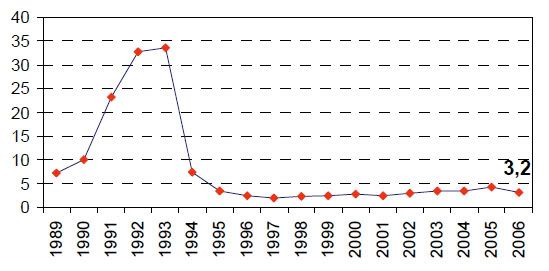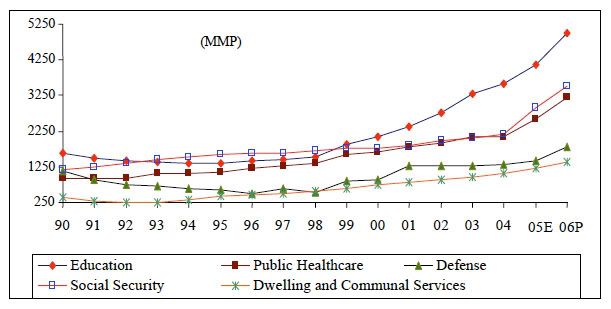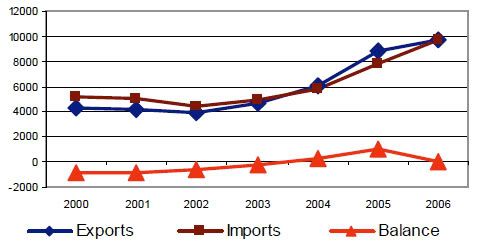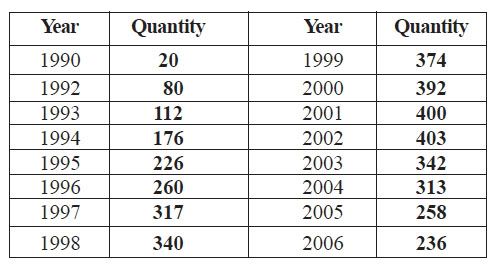Abstract
The collapse of the European socialist block at the end of the 1980s caused a deep crisis in the Cuban economy. One of the distinctive features of the process of adjustment and reform of the Cuban economy carried out by the government was that even during the worst period of the crisis, the Revolution’s main social achievements in education, healthcare and social security were preserved. At the same time, the measures introduced by the government succeeded in the following areas: resumption of economic growth; sectoral diversification and reinsertion into the world markets; and partial correction of some key internal economic imbalances. While the government is involved in the design of several economic policy measures to face the remaining challenges, the preservation of the social achievements and the prevalence of state property in most relevant economic sectors have been confirmed as key strategic principles.
Introduction
The collapse of the European socialist block at the end of the 1980s prompted a deep crisis in the Cuban economy. The latter lost its main supplier of equipment, raw materials, food and fuels. The block was the market for over 80% of Cuba’s exports, which in turn defined its insertion into the world market. It was the source for spare parts and technical assistance for most of the technology installed in the preceding 30 years. It was also the source of financing and economic preferences.
At the same time, the United States reinforced its economic embargo with several additional measures aimed at defeating the Cuban Revolution for good.
This paper will summarize the consequences of the collapse of the European socialist system for the Cuban economy. It will examine the strategy adopted to face the crisis and to reorient the economy to the changed circumstances. The results of this strategy will then be studied from the economic and social points of view. Finally, the paper will look at the major current problems and challenges, and the economic policy devised to deal with them.
Impact of the Collapse of the European Socialist System on the Cuban Economy
The collapse of the European socialist system had a deep impact on the Cuban macroeconomic indicators. Gross Domestic Product (GDP), investment and foreign trade registered an outstanding slump. The crisis had an even more significant impact on the population’s living standards.
However, in sharp contrast to adjustment programmes in other developing countries, not a single school, hospital or university was closed down. Not a single worker was fired. The domestic research and development system, far from being dismantled, became a part of the strategy to overcome the crisis.
This, however, came at a price. The budget deficit and money supply increased, leading to significant inflationary pressures and a sharp depreciation of the Cuban peso.
Effects of the External Shock: 1990-1993
Source: Banco Nacional de Cuba, Informe Económico, Mayo 1996.
Dealing with the Crisis
In this context, the government introduced a set of measures aimed at facing the crisis and then ultimately reversing it.
A macroeconomic adjustment policy was implemented to correct some of the key imbalances. Among others, this included the enforcement of a strict fiscal discipline, drastic spending cuts in armed forces and central administration, and monetary policy measures aimed at containing inflation and stabilizing the national currency.
This was followed by the introduction of structural reforms. The reforms comprised of decentralization and reorientation of foreign trade, opening up to foreign investment, restructuring the banking system, rationalization of the state enterprise system and management decentralization.
The limited resources available were concentrated in a few sectoral programmes like tourism, biotech, food self-sufficiency and oil & gas prospecting. The goal was to develop hard currency earners as well as substitute imports. The US dollar was allowed to circulate in the country and dollar remittances were permitted. A network of state dollar shops was set up to collect and redistribute the proceeds.
The development of medical services and infrastructure continued, not only for Cuban nationals, but also for international cooperation and exports.
Changes were also made in the property structure. Private agricultural markets were reintroduced; the same was the case with private industrial and handicraft markets, self-employment and small private property. Most state lands and state agricultural companies were transformed into semi-private cooperatives.
However, a significant element of the Cuban economic reform was that state property prevailed in most key sectors.
The main goals of the strategy were:
- To preserve the country’s independence;
- To keep and improve socialism; and
- To create the economic and social basis to re-launch a development programme once the crisis was over.
Results of the Strategy
During the first few years of the 1990s, the GDP contracted significantly. But by 1994 it had started to recover slightly and registered an average annual growth rate of 4.3% in the 1994-2000 period.
GDP. Annual Rate. Prices 97
Source: Oficina Nacional de Estadísticas (ONE): Anuario Estadístico de Cuba, 2001.
Despite the deceleration in 2001, economic growth picked up pace in 2003 and averaged 6.3% for the period 2001-2006.
GDP. Annual Rates. Prices 97.
Source: 2001-2005 — ONE: Anuario Estadístico de Cuba, 2005. 2006 — Ministerio de Economía y Planificación: Informe sobre los resultados económicos y sociales del año 2006 a la Asamblea Nacional del Poder Popular.
The significant expansion during 2005-06 can be attributed to a combination of factors. The first is the mutually convenient preferential agreements with Venezuela, particularly the exchange of healthcare services for oil, together with soft financing also from Venezuela, China and other friendly countries. The second is an upward trend in the prices for key Cuban exports like nickel and sugar. And the third is the positive performance of sectors like tourism and biotechnology that were part of the development strategy designed earlier.
The success of Cuba’s reinsertion into the world trading system, following the collapse of the European socialist block, brought about changes in the contribution and relative weight of several economic sectors to GDP growth. They are summarised below:
- The sugar industry, the country’s traditional economic engine of growth, now plays a secondary role.
- Sugar has been replaced as the leading sector by tourism and, more recently, by exports of high value-added services (mainly healthcare assistance and licenses on biotech patents).
- Nickel output has increased and, thanks to the significant upward trend in international prices, currently ranks first among exports of goods.
- Remittances, which were insignificant until the late 1980s, are currently among the key sources of income in the balance of payments.
- The domestic oil and gas output, negligible until 1990, today guarantees about 50% of the country’s energy requirements, and is expected to become an important export item in the near future.
- Foreign investment, virtually non-existent in 1990, has become a major determinant of the development of some of the key sectors like tourism, nickel and energy.
Another important outcome of the measures taken in the 1990s was the reduction of budget deficits, which have averaged around 3% of GDP since 1993.
Budget Deficit/GDP
Source: Figures taken from ONE: Anuario Estadístico de Cuba, 2005.
However, expenditures on education, healthcare and social security continued expanding; this was done in order to preserve the Revolution’s main social achievements.
Public Expenditures in the Domestic Budget
Source: United Nations, Economic Commission for Latin America and the Caribbean (ECLAC): Cuba, Evolución Económica en el 2005 y Perspectivas para el 2006.
This policy resulted in a gradual decrease in unemployment. The unemployment figure for last three years was just 1.9%.
Unemployment
Source: Ministerio de Economía y Planificación: Informe sobre los resultados económicos y socials del año 2006 a la Asamblea Nacional del Poder Popular.
As far as the external sector is concerned, both exports and imports of goods and services have increased in the last few years. It has also remained rather balanced in the last 7 years.
Foreign Trade: Goods and Services
Source: 2001-2005 — ECLAC: Cuba. Evolución Económica en el 2005 y Perspectivas para el 2006. 2006 — Calculation based on the growth rates reported by Panorama Económico y Social de Cuba. ONE, December 2006.
However, if exports of goods are considered independently, an outstanding deficit becomes apparent. This deficit showed an upward trend in the last four years because the import capacity of the country increased and exports of some traditional goods contracted.
Trade of Goods
Source: ONE: Anuario Estadístico de Cuba 2005; Panorama Económico y Social de Cuba 2006.
In the last 15 years, the structure of Cuba’s exports of goods has changed significantly. Some traditional cash earners like sugar, coffee and citrus have lost relevance; they have been replaced by others like nickel, tobacco and medical products.
Goods Exports Structure
Source: ECLAC: Cuba. Evolución Económica en el 2005 y Perspectivas para el 2006.
A pattern has emerged in the last few years wherein the deficit in the goods account of the balance of payments has been counterbalanced by a remarkable increase in exports of services, particularly medical assistance, tourism, education, engineering and, increasingly, licensing on biotech patents.
Exports of Services
Source: 2000-2005 — ECLAC: Cuba. Evolución Económica en el 2005 y Perspectivas para el 2006. 2006 — ECLAC: Balance Preliminar de las Economías de América Latina y el Caribe. 2006.
As a result, a clear structural change has taken place in Cuba’s balance of payments in the last 15 years. Services have definitively displaced goods as the main cash earner, moving from just 10% of total revenues in 1989 to about 70% in 2005.
Structure of Cuban Exports
Source: ECLAC: Cuba. Evolución Económica en el 2005 y Perspectivas para el 2006.
Due to the previously described developments, the current account balance has been improving in recent years and has registered positive figures since 2004.
Current Account
Source: ECLAC: Cuba. Evolución Económica en el 2005 y Perspectivas para el 2006.
Opening up to foreign investments was another key component of the strategy designed in the early 1990s to face the crisis and create the conditions for future development.
The Cuban reforms concerning foreign investments had three components:
- There was no privatization of public assets;
- Foreign investors were not allowed to buy or set up wholly-owned companies. They were allowed only as partners in joint ventures with Cuban state companies; and
- The approval of new projects was always subject to a “case by case” analysis, considering the country’s interests and priorities.
This policy has remained basically unchanged, but currently its key feature is selectivity.
- Most small joint ventures with low turnovers have been terminated; and
- Most new approvals are now for outstanding projects in key sectors like oil & gas, electricity, nickel and tourism.
As a result, while the number of operational associations with foreign capital has decreased, their total sales, exports and dividends for the country have increased.
Operational Joint Ventures
Source: Reports of the Ministry of Foreign Investments and Economic Collaboration, 2002, 2003; Workshop on “International Insertion, Macroeconomic Management and Regulation: Cuba and International Experience”, Institut des Hautes Etudes France — Asociación Nacional de Economistas de Cuba, February 2006.
Foreign Direct Investment Performance
Source: Reports of the Ministry of Foreign Investments and Economic Collaboration, 2002, 2003; Workshop on “International Insertion, Macroeconomic Management and Regulation: Cuba and International Experience”, Institut des Hautes Etudes France — Asociación Nacional de Economistas de Cuba, February 2006.
An important feature of the Cuban development model is the prioritization of social policies. Even during the worst crisis years in the 1990s, the government managed to preserve most of the relevant social improvements achieved after the revolution. Thus, despite the sudden slump in living standards and the depth of the economic reforms, social and political stability prevailed and in turn allowed gradual economic recovery.
As soon as this recovery started, the social content of the economic policy was reinforced in three main areas:
- The educational system was improved and enhanced at all levels, from primary schools to universities. Most facilities were repaired and new classrooms were built; the number of students per teacher was reduced and every school received TV sets, videos and computers.
- The universal, free healthcare system kept receiving significant government funding. The strategy continued emphasizing a preventive approach, and allowed further decreases in key indicators like infant and maternal mortality. A programme to refurbish and expand all hospitals and polyclinics is now almost complete; this includes the installation of state-of-the-art technology. Huge investments have also been made for the expansion of the pharmaceutical and biotechnology research, development and manufacturing capabilities.
- Despite the prevailing limitations in the availability of resources, several wage increases, with a two-pronged approach, have been implemented. Selective pay raises have taken place in key sectors like healthcare, sanitation and education in the last few years. The government has also decreed overall hikes in salaries, pensions and social assistance.
Current Challenges and Policies
The policies introduced to stop and then reverse the crisis of the 1990s can claim successes in the resumption of economic growth, the sectoral diversification and reinsertion into the world markets, and the partial correction of some key internal economic imbalances. But the Cuban economy still faces both pending and new challenges.
Some of these challenges are: the low productivity prevailing in some manufacturing sectors and most of the agricultural sector; increase of petty corruption; the critical condition of infrastructure, dwellings and transportation; and the need to eliminate the dual currency system introduced to face the crisis, as a condition for economic rationality.
In order to face these challenges, a set of economic policy measures have been devised. For example, to increase the productivity in manufacturing and agriculture, the government has deepened the restructuring of state companies, emphasizing on accounting, control and discipline. Cooperatives and other flexible schemes are being extended in agriculture and state companies, including state financing. Also, foreign investment has been allowed and promoted in particular areas.
To face the rise of corruption cases, a partial re-centralization took place in most sectors. Besides, foreign exchange controls were re-established. Approval was made a requirement for high-value import transactions, and revenues of state companies were concentrated in a single account at the central bank.
Given the critical condition of infrastructure, dwelling and transportation, a programme is being implemented for the construction of 70,000 new houses and the refurbishment of 150,000 houses per year. Another programme, designed for the gradual recovery of transportation, will take 2-3 years to complete. Particularly important is the actual energy revolution that has been taking place in the last few years; this comprises saving measures and a massive technological upgrading of electricity generation equipment and the distribution network. Partial investments have also started in highways, water pipelines, ports, etc.
Finally, to move away from the current dual currency system, the first step taken was to withdraw the US dollar from the domestic economy. State companies were forbidden to sell some goods and services in Cuban Convertible Pesos (CUCs). The current course of action is for a gradual revaluation of the two Cuban currencies, bringing one close to the other in order to facilitate the final unification.
Conclusions
The collapse of the European socialist block at the end of the 80s caused a deep crisis in the Cuban economy. This was reflected in an outstanding fall in all of its macroeconomic indicators and the population’s living standards.
In this context, the government introduced a set of measures aimed at facing and then reversing the crisis. It succeeded in the following areas: resumption of economic growth, sectoral diversification and reinsertion into the world markets, and partial correction of some key internal economic imbalances.
One of the distinctive features of the process of adjustment and reform of the Cuban economy was that, even during the worst period of the crisis, the Revolution’s main social achievements (education, healthcare and social security) were preserved.
Despite the successes of the policies implemented, the Cuban economy faces both pending and new challenges. Some of these are: the low productivity prevailing in some manufacturing sectors and most of the agriculture; increase in petty corruption; the critical condition of dwellings, transportation and part of the infrastructure; and the need to eliminate the dual currency system.
To face these challenges, the government is currently involved in the design and introduction of several economic policy measures. In this new context, both the preservation of the social achievements of the revolution and the prevalence of state property in most relevant economic sectors have been confirmed as key strategic principles.
Notes
* Paper presented at the International Conference on “Policy Perspectives on Growth, Economic Structures and Poverty Reduction”, Organized by International Development Economics Associates (IDEAs) and Tsinghua University, Beijing, China, 7-9 June 2007.
References
Banco Nacional de Cuba: Informe Económico, Mayo 1996.
Institut des Hautes Etudes France and Asociación Nacional de Economistas de Cuba: Workshop on “International insertion, macroeconomic management and regulation: Cuba and International Experience”, February 2006.
Ministerio de Economía y Planificación: Informe sobre los resultados económicos y sociales del año 2006 a la Asamblea Nacional del Poder Popular.
Ministerio de Inversión Extranjera y Colaboración Económica: Informes Económicos Anuales.
Oficina Nacional de Estadísticas: Anuarios Estadísticos de Cuba.
Oficina Nacional de Estadísticas: Panorama Económico y Social de Cuba, 2006.
The Economist Intelligence Unit: Country Report, Cuba, November 2006.
United Nations, Economic Commission for Latin America and the Caribbean: Balance Preliminar de las Economías de América Latina y el Caribe, 2006.
United Nations, Economic Commission for Latin America and the Caribbean: Cuba, Evolución Económica en el 2005 y Perspectivas para el 2006.
Elda Molina Díaz is a Senior Researcher at the Centre for Research on International Economics, Havana University, Cuba. This article was first published by the International Development Economics Associates on 21 March 2009; it is reproduced here for educational purposes.
